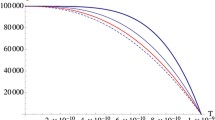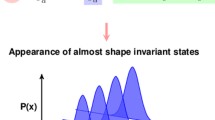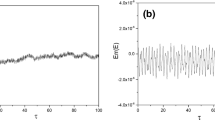Abstract
We study the Bose–Einstein condensates (BEC) in two or three dimensions with attractive interactions, described by \(L^{2}\) constraint Gross-Pitaevskii energy functional. First, we give the precise description of the chemical potential of the condensate \(\mu \) and the attractive interaction a. Next, for a class of degenerate trapping potential with non-isolated critical points, we obtain the existence and the local uniqueness of the excited states by accurately analyzing the location of the concentrated points and the Lagrange multiplier. Our results on degenerate trapping potential with non-isolated critical points are new for ground states of BEC and singularly perturbed nonlinear Schrödinger equations.
Similar content being viewed by others
References
Ambrosetti, A., Badiale, M., Cingolani, S.: Semiclassical states of nonlinear Schrödinger equations. Arch. Rat. Mech. Anal. 140, 285–300 (1997)
Anderson, M., Ensher, J., Matthews, M., Wieman, C., Cornell, E.: Observation of Bose–Einstein condensation in a dilute atomic vapor. Science 269, 198–201 (1995)
Bao, W., Cai, Y.: Mathmatical theory and numerical methods for Bose–Einstein condensation. Kinet. Relat. Models 6, 1–135 (2013)
Bloch, I., Dalibard, J., Zwerger, W.: Many-body physics with ultracold gases. Rev. Mod. Phys. 80, 885 (2008)
Byeon, J., Jeanjean, L.: Standing waves for nonlinear Schrödinger equations with a general nonlinearity. Arch. Rat. Mech. Anal. 185, 185–200 (2007)
Cao, D., Heinz, H.: Uniqueness of positive multi-lump bound states of nonlinear Schrödinger equations. Math. Z. 243, 599–642 (2003)
Cao, D., Li, S., Luo, P.: Uniqueness of positive bound states with multi-bump for nonlinear Schrödinger equations. Calc. Var. Partial Differ. Equ. 54, 4037–4063 (2015)
Cao, D., Noussair, E., Yan, S.: Existence and uniqueness results on single-peaked solutions of a semilinear problem. Ann. Inst. H. Poincaré Anal. Non Linéaire 15, 73–111 (1998)
Cao, D., Noussair, E., Yan, S.: Solutions with multiple peaks for nonlinear elliptic equations. Proc. R. Soc. Edinb. 129A, 235–264 (1999)
Cao, D., Peng, S.: Semi-classical bound states for Schrödinger equations with potentials vanishing or unbounded at infinity. Commun. Partial Differ. Equ. 34, 1566–1591 (2009)
Cornell, E., Wieman, C.: Nobel Lecture: Bose-Einstein condensation in a dilute gas, the first 70 years and some recent experiments. Rev. Mod. Phys. 74, 875–893 (2002)
Dancer, E., Yan, S.: Interior and boundary peak solutions for a mixed boundary value problem. Indiana Univ. Math. J. 48, 1177–1212 (1999)
Dancer, E., Yan, S.: On the existence of multipeak solutions for nonlinear field equations on \({\mathbb{R}}^N\). Discrete Contin. Dynam. Syst. 6, 39–50 (2000)
Davis, K., Mewes, M., Andrews, M., van Druten, N., Durfee, D., Kurn, D., Ketterle, W.: Bose-Einstein condensation in a gas of sodium atoms. Phys. Rev. Lett. 75, 3969–3973 (1995)
Deng, Y., Lin, C., Yan, S.: On the prescribed scalar curvature problem in \({\mathbb{R}}^N\), local uniqueness and periodicity. J. Math. Pures Appl. 104, 1013–1044 (2015)
Floer, A., Weinstein, A.: Nonspreading wave packets for the cubic Schrödinger equation with a bounded potential. J. Funct. Anal. 69, 397–408 (1986)
Glangetas, L.: Uniqueness of positive solutions of a nonlinear elliptic equation involving the critical exponent. Nonlinear Anal. 20, 571–603 (1993)
Gross, E.: Structure of a quantized vortex in boson systems. Nuovo Cimento 20, 454–466 (1961)
Grossi, M.: On the number of single-peak solutions of the nonlinear Schrödinger equations. Ann. Inst. H. Poincaré Anal. Non Linéaire 19, 261–280 (2002)
Grossi, M., Pistoia, A.: Locating the peak of ground states of nonlinear Schr?Dinger equations. Houston J. Math. 31, 621–635 (2005)
Guo, H., Zhou, H.: A constrained variational problem arising in attractive Bose–Einstein condensate with ellipse-shaped potential. Appl. Math. Lett. 87, 35–41 (2019)
Guo, Y., Lin, C., Wei, J.: Local uniqueness and refined spike profiles of ground states for two-dimensional attractive Bose–Einstein condensates. SIAM J. Math. Anal. 49, 3671–3715 (2017)
Guo, Y., Seiringer, R.: On the mass concentration for Bose–Einstein condensates with attractive interactions. Lett. Math. Phys. 104, 141–156 (2014)
Guo, Y., Wang, Z., Zeng, X., Zhou, H.: Properties of ground states of attractive Gross–Pitaevskii equations with multi-well potentials. Nonlinearity 31, 957–979 (2018)
Guo, Y., Zeng, X., Zhou, H.: Energy estimates and symmetry breaking in attractive Bose-Einstein condensates with ring-shaped potentials. Ann. Inst. H. Poincaré Anal. Non Linéaire 33, 809–828 (2016)
Guo, Y.X., Peng, S., Yan, S.: Local uniqueness and periodicity induced by concentration. Proc. Lond. Math. Soc. 114, 1005–1043 (2017)
Ketterle, W.: Nobel lecture: When atoms behave as waves: Bose-Einstein condensation and the atom laser. Rev. Mod. Phys. 74, 1131–1151 (2002)
Lieb, E., Seiringer, R., Solovej, J., Yngvason, J.: The mathematics of the Bose gas and its condensation. Oberwolfach Seminars, vol. 34. Birkhauser Verlag, Basel (2005)
Lieb, E., Seiringer, R., Yngvason, J.: A rigorous derivation of the Gross–Pitaevskii energy functional for a two-dimensional Bose gas. Commun. Math. Phys. 224, 17–31 (2001)
Lu, G., Wei, J.: On nonlinear Schrödinger equations with totally degenerate potentials. C. R. Acad. Sci. Paris Sér. I Math. 326(6), 691–696 (1998)
Pitaevskii, L.: Vortex lines in an imperfect Bose gas. Sov. Phys. JETP 13, 451–454 (1961)
Rabinowitz, P.: On a class of nonlinear Schrödinger equations. Z. Angew. Math. Phys. 43, 270–291 (1992)
Author information
Authors and Affiliations
Corresponding author
Ethics declarations
Conflict of Interest
All authors declare that they have no conflict of interest.
Ethical approval
This article does not contain any studies with human participants or animals performed by the authors.
Additional information
Communicated by Manuel del Pino.
Publisher's Note
Springer Nature remains neutral with regard to jurisdictional claims in published maps and institutional affiliations.
Luo and Peng were supported by the Key Project of NSFC (No.11831009). Luo was partially supported by NSFC Grants (No.11701204). The research of J. Wei is partially supported by NSERC of Canada (RGPIN-2018-03773). Yan was supported by NSFC Grants (No.11629101)
Appendices
Appendix
A. The kernel of a linear operator
Lemma A.1
Let \(\xi _0:=(\xi _1,\cdots ,\xi _k)\) be a bounded solution of following system:
Then for \(N=2,3\), it holds
where \(\gamma _{i,j}\) are some constants,
Moreover, \(\gamma _{i,0}=\gamma _{l,0}\) for all \(i,l=1,\cdots ,k\).
Proof
Noting that Q(x) is a radial function, using the technique of the separation of variables, we can prove
where \(\gamma _{i, j}\) is some constant, and \(\xi _{i, 0}\) is a radial function, satisfying
We set \(\bar{L}(u):=-\Delta u(x)+\big (1-3Q^2(x)\big )u(x)\). Then
Since \(\bar{L}\) has no non-trivial bounded radially symmetric kernel, it holds
Using (3.12), we find that \(\gamma _{i, 0} \) satisfies
which gives \(\gamma _{i,0}=\gamma _{l,0}\) for all \(i,l=1,\cdots ,k\). \(\square \)
B. Calculations involving curvatures
Now let \(\Gamma \in C^2\) be a closed hypersurface in \({\mathbb {R}}^N\). For \(y\in \Gamma \), let \(\nu (y)\) and T(y) denote respectively the outward unit normal to \(\Gamma \) at y and the tangent hyperplane to \(\Gamma \) at y. The curvatures of \(\Gamma \) at a fixed point \(y_0\in \Gamma \) are determined as follows. By a rotation of coordinates, we can assume that \(y_0=0\) and \(\nu (0)\) is the \(x_N\)-direction, and \(x_j\)-direction is the j-th principal direction.
In some neighborhood \({\mathcal {N}}={\mathcal {N}}(0)\) of 0, we have
where \(x'=(x_1,\cdots ,x_{N-1})\),
where \(\kappa _j\), is the j-th principal curvature of \(\Gamma \) at 0. The Hessian matrix \([D^2 \varphi (0)]\) is given by
Suppose that W is a smooth function, such that \(W(x)=a\) for all \(x\in \Gamma \).
Lemma B.1
We have
where \(\kappa _1,\cdots ,\kappa _{N-1}\), are the principal curvatures of \(\Gamma \) at 0.
Proof
First, we have \(W\big (x',\varphi (x')\big )=0\). And then we find
Letting \(x'=0\) in (B.3), we obtain (B.1).
Differentiating (B.3) with respect to \(x_l\) for \(l=1,\cdots ,N-1\), we get
Let \(x'=0\) in (B.4), then we get (B.2). \(\square \)
C. An example
In this section, we use the above results to the following potential V(x). Let
where \(a_j>0\), \(a_j\ne a_l\) for \(j\ne l\). Let \(\Gamma _i\) is defined by \(F_i(x)=0\) with \(i=1,2\). Take
and
Lemma C.1
All critical points \(\Delta V\) on \(\Gamma _1\) are \((\pm a_1,0,\cdots , 0), \cdots , (0,\cdots , 0, \pm a_N)\).
Proof
First, we find
To find a critical point \(\Delta V\) on \(\Gamma \), we need to study the following equation
for some unknown constant \(\lambda \). That is,
Thus, either \(x_l=0\), or \(\lambda = 4 \displaystyle \sum _{k=1}^N \frac{1}{a_k^2} + \frac{8}{a_l^2}\). If \(\lambda =4 \displaystyle \sum _{k=1}^N \frac{1}{a_k^2} + \frac{8}{a_l^2}\), then \(x_j=0\) for all \(j\ne l\). This shows that all critical points \(\Delta V\) on \(\Gamma \) are \((\pm a_1,0,\cdots , 0), \cdots , (0,\cdots , 0, \pm a_N)\). \(\square \)
Without loss of generality, we consider the point \(b_1=(0,\cdots , 0, a_N)\). In this case, \(\tau _j\) is the \(x_j\) direction, \(j=1, \cdots , N-1\), and \(\nu \) is the \(x_N\) direction.
Lemma C.2
If \(a_l\ne a_j\) for \(l\ne j\). Thus, \(b_1\) is non-degenerate on \(\Gamma _1\).
Proof
We have
On \(\Gamma _1\), it holds
This gives
which is non-singular since \(a_l\ne a_j\) for \(l\ne j\). Thus, \(b_1\) is also non-degenerate on \(\Gamma _1\). \(\square \)
Lemma C.3
The matrix
is non singular if one of the following conditions holds
-
(1)
\(a_N<a_l\), \(l=1,\cdots , N-1\).
-
(2)
\(a_N>a_l\), \(l=1,\cdots , N-1\) and all the \(a_i\) are close to a constant.
Proof
Near \(b_1=(0,\cdots , 0, a_N)\), \(\Gamma \) is given by
Thus, \(\kappa _l = -\frac{ a_N }{a_l^2},\quad l=1,\cdots , N-1\). So we have
If \(x_0\) is a maximum point of \(\Delta V\) on \(\Gamma \), that is \(a_N<a_l\), \(l=1,\cdots , N-1\), then \(\Big (\frac{\partial ^2 \Delta V(x_0)}{\partial x_lx_j}\Big )_{1\le l,j\le N-1}\) is negative. Thus, (C.1) is also a negative matrix. On the other hand, if \(b_1\) is a minimum point of \(\Delta V\) on \(\Gamma _1\) and all the \(a_j\) are close to a constant, that is \(a_N>a_l\), \(l=1,\cdots , N-1\), then (C.1) is negative. \(\square \)
Finally, for \(b_2=(0,\cdots ,0,4a_N)\in \Gamma _2\), we have the similar results.
Rights and permissions
About this article
Cite this article
Luo, P., Peng, S., Wei, J. et al. Excited states of Bose–Einstein condensates with degenerate attractive interactions. Calc. Var. 60, 155 (2021). https://doi.org/10.1007/s00526-021-02046-x
Received:
Accepted:
Published:
DOI: https://doi.org/10.1007/s00526-021-02046-x




